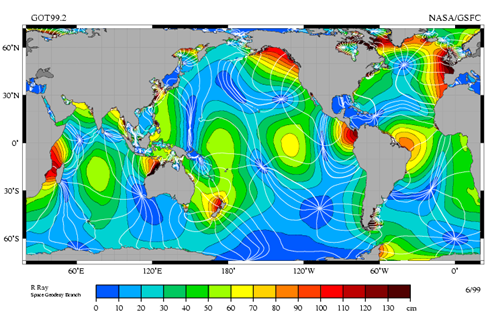Mathematical model for quay crane assignment problem with tidal constraints
DOI:
https://doi.org/10.17981/ingecuc.17.1.2021.14Keywords:
tides, quay assignment, mixed integer programming, container terminalAbstract
Objetive: The operations associated with loading and unloading of container ships demand the use of quay cranes that represent one of the most expensive resources of a maritime terminal. Therefore, the assignment of cranes to ships must be optimized. This article proposes a mathematical model to optimize the decision of assignment of cranes to ships, considering the behavior of tides, which is a not commonly considered factor in the scientific literature for similar problems.
Metodology: A mixed integer linear mathematical model was designed and tested for the actual case of a container terminal in Buenaventura-Colombia with satisfactory results.
Results: With the available capacity the model allows to mobilize up to 2800 containers per half day, while the number of containers per ship in the real case does not exceed 2000 units.
Conclusions: The consideration of tides, combined with downtime penalty cost can allow using smaller number of cranes with savings in energy cost.
Downloads
References
R. I. Peterkofsky & C. F. Daganzo, “A branch and bound solution method for the crane scheduling problem,” Transp Res Part B-Meth, vol. 24, no. 3, pp. 159–172, Jun. 1990. https://doi.org/10.1016/0191-2615(90)90014-P
A. Diabat & E. Theodorou, “An Integrated Quay Crane Assignment and Scheduling Problem,” Comput Ind Eng, vol. 73, no. 1 , pp. 115–123, Jul. 2014. https://doi.org/10.1016/j.cie.2013.12.012
L. Moccia, J. F. Cordeau, M. Gaudioso & G. Laporte, “A branch-and-cut algorithm for the quay crane scheduling problem in a container terminal,” Nav Res Logist, vol. 53, no. 1, pp. 45–59, 2006. https://doi.org/10.1002/nav.20121
S. H. Jung & K. H. Kim, “Load scheduling for multiple quay cranes in port container terminals,” J Intell Manuf, vol. 17, no. 4, pp. 479–492, 2006. https://doi.org/10.1007/s10845-005-0020-y
W. C. Ng & K. L. Mak, “Quay crane scheduling in container terminals,” Eng Optim, vol. 38, no. 6, pp. 723–737, 2006. https://doi.org/10.1080/03052150600691038
K. H. Kim & Y. M. Park, “A crane scheduling method for port container terminals,” Eur J Oper Res, vol. 156, no. 3, pp. 752–768, Aug. 2004. https://doi.org/10.1016/S0377-2217(03)00133-4
A. V. Goodchild & C. F. Daganzo, “Double-Cycling Strategies for Container Ships and Their Effect on Ship Loading and Unloading Operations,” Transp Sci, vol. 40, no. 4, pp. 473–483, Nov. 2006. https://doi.org/10.1287/trsc.1060.0148
A. V. Goodchild & C. F. Daganzo, “Crane double cycling in container ports: Planning methods and evaluation,” Transp Res Part B:Meth, vol. 41, no. 8, pp. 875–891, Oct. 2007. https://doi.org/10.1016/j.trb.2007.02.006
H. Zhang & K. H. Kim , “Maximizing the number of dual-cycle operations of quay cranes in container terminals,” Comput Ind Eng, vol. 56, no. 3, pp. 979–992, Apr. 2009. https://doi.org/10.1016/j.cie.2008.09.008
A. Lim, B. Rodrigues, F. Xiao & Y. Zhu, “Crane scheduling with spatial constraints,” Nav Res Logist, vol. 51, no. 3, pp. 386–406, 2004. https://doi.org/10.1002/nav.10123
D. H. Lee, H. Q. Wang & L. Miao, “Quay crane scheduling with non-interference constraints in port container terminals,” Transp Res Part E Logist Transp Rev, vol. 44, no. 1, pp. 124–135, Jan. 2008. https://doi.org/10.1016/j.tre.2006.08.001
J. He, “Berth allocation and quay crane assignment in a container terminal for the trade-off between time-saving and energy-saving,” Adv Eng Inform, vol. 30, no. 3, pp. 390–405, 2016. https://doi.org/10.1016/j.aei.2016.04.006
S. Yu, S. Wang & L. Zhen, “Quay crane scheduling problem with considering tidal impact and fuel consumption,” Flex Serv Manuf J, vol. 29, pp. 345–368, Dec. 2017. https://doi.org/10.1007/s10696-016-9248-4
A. Sheikholeslami, G. Ilati & M. Kobari, “The continuous dynamic berth allocation problem at a marine container terminal with tidal constraints in the access channel,” IJCE, vol. 12, no. 3 and A, pp. 344–353, 2014. Available: http://ijce.iust.ac.ir/article-1-848-en.html
Y. Du, Q. Chen, J. S. L. Lam, Y. Xu & J. X. Cao, “Modeling the impacts of tides and the virtual arrival policy in berth allocation,” TRSC, vol. 49, no. 3, pp. 939–956, 2015. https://doi.org/10.1287/trsc.2014.0568
D. Xu, C.L. Li & J.Y.T. Leung, “Berth allocation with time-dependent physical limitations on vessels,” Eur J Oper Res, vol. 216, no. 1, pp. 47–56, Jan. 2012. https://doi.org/10.1016/j.ejor.2011.07.012
O. Doerr & R. J. Sanchez, “Indicadores de productividad para la industria portuaria. Aplicable en América Latina y el Caribe,” CEPAL, SFGO, CL: ONU, pp. 1–76, 2006. Available: https://www.oas.org/cip/docs/areas_tecnicas/6_exelencia_gestion_port/3_ind_de_produc.pdf

Published
How to Cite
Issue
Section
License
Copyright (c) 2021 INGE CUC

This work is licensed under a Creative Commons Attribution-NonCommercial-NoDerivatives 4.0 International License.
Published papers are the exclusive responsibility of their authors and do not necessary reflect the opinions of the editorial committee.
INGE CUC Journal respects the moral rights of its authors, whom must cede the editorial committee the patrimonial rights of the published material. In turn, the authors inform that the current work is unpublished and has not been previously published.
All articles are licensed under a Creative Commons Attribution-NonCommercial-NoDerivatives 4.0 International License.


 English
English
 Español (España)
Español (España)






















